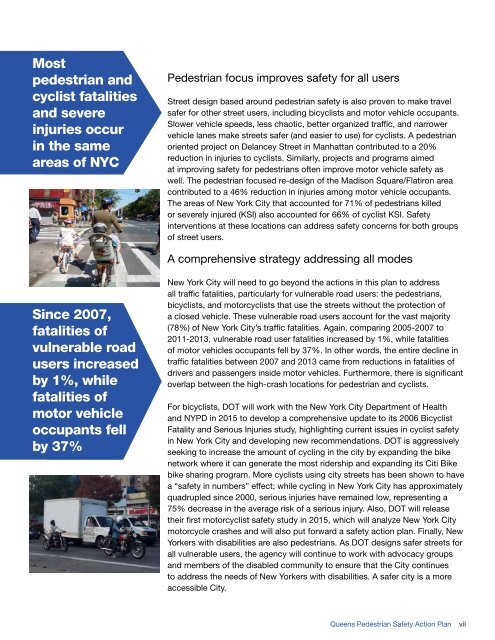ped-safety-action-plan-queens
ped-safety-action-plan-queens
ped-safety-action-plan-queens
You also want an ePaper? Increase the reach of your titles
YUMPU automatically turns print PDFs into web optimized ePapers that Google loves.
Most<br />
<strong>ped</strong>estrian and<br />
cyclist fatalities<br />
and severe<br />
injuries occur<br />
in the same<br />
areas of NYC<br />
Pedestrian focus improves <strong>safety</strong> for all users<br />
Street design based around <strong>ped</strong>estrian <strong>safety</strong> is also proven to make travel<br />
safer for other street users, including bicyclists and motor vehicle occupants.<br />
Slower vehicle speeds, less chaotic, better organized traffic, and narrower<br />
vehicle lanes make streets safer (and easier to use) for cyclists. A <strong>ped</strong>estrian<br />
oriented project on Delancey Street in Manhattan contributed to a 20%<br />
reduction in injuries to cyclists. Similarly, projects and programs aimed<br />
at improving <strong>safety</strong> for <strong>ped</strong>estrians often improve motor vehicle <strong>safety</strong> as<br />
well. The <strong>ped</strong>estrian focused re-design of the Madison Square/Flatiron area<br />
contributed to a 46% reduction in injuries among motor vehicle occupants.<br />
The areas of New York City that accounted for 71% of <strong>ped</strong>estrians killed<br />
or severely injured (KSI) also accounted for 66% of cyclist KSI. Safety<br />
interventions at these locations can address <strong>safety</strong> concerns for both groups<br />
of street users.<br />
A comprehensive strategy addressing all modes<br />
Since 2007,<br />
fatalities of<br />
vulnerable road<br />
users increased<br />
by 1%, while<br />
fatalities of<br />
motor vehicle<br />
occupants fell<br />
by 37%<br />
New York City will need to go beyond the <strong>action</strong>s in this <strong>plan</strong> to address<br />
all traffic fatalities, particularly for vulnerable road users: the <strong>ped</strong>estrians,<br />
bicyclists, and motorcyclists that use the streets without the protection of<br />
a closed vehicle. These vulnerable road users account for the vast majority<br />
(78%) of New York City’s traffic fatalities. Again, comparing 2005-2007 to<br />
2011-2013, vulnerable road user fatalities increased by 1%, while fatalities<br />
of motor vehicles occupants fell by 37%. In other words, the entire decline in<br />
traffic fatalities between 2007 and 2013 came from reductions in fatalities of<br />
drivers and passengers inside motor vehicles. Furthermore, there is significant<br />
overlap between the high-crash locations for <strong>ped</strong>estrian and cyclists.<br />
For bicyclists, DOT will work with the New York City Department of Health<br />
and NYPD in 2015 to develop a comprehensive update to its 2006 Bicyclist<br />
Fatality and Serious Injuries study, highlighting current issues in cyclist <strong>safety</strong><br />
in New York City and developing new recommendations. DOT is aggressively<br />
seeking to increase the amount of cycling in the city by expanding the bike<br />
network where it can generate the most ridership and expanding its Citi Bike<br />
bike sharing program. More cyclists using city streets has been shown to have<br />
a “<strong>safety</strong> in numbers” effect; while cycling in New York City has approximately<br />
quadrupled since 2000, serious injuries have remained low, representing a<br />
75% decrease in the average risk of a serious injury. Also, DOT will release<br />
their first motorcyclist <strong>safety</strong> study in 2015, which will analyze New York City<br />
motorcycle crashes and will also put forward a <strong>safety</strong> <strong>action</strong> <strong>plan</strong>. Finally, New<br />
Yorkers with disabilities are also <strong>ped</strong>estrians. As DOT designs safer streets for<br />
all vulnerable users, the agency will continue to work with advocacy groups<br />
and members of the disabled community to ensure that the City continues<br />
to address the needs of New Yorkers with disabilities. A safer city is a more<br />
accessible City.<br />
Queens Pedestrian Safety Action Plan<br />
vii


